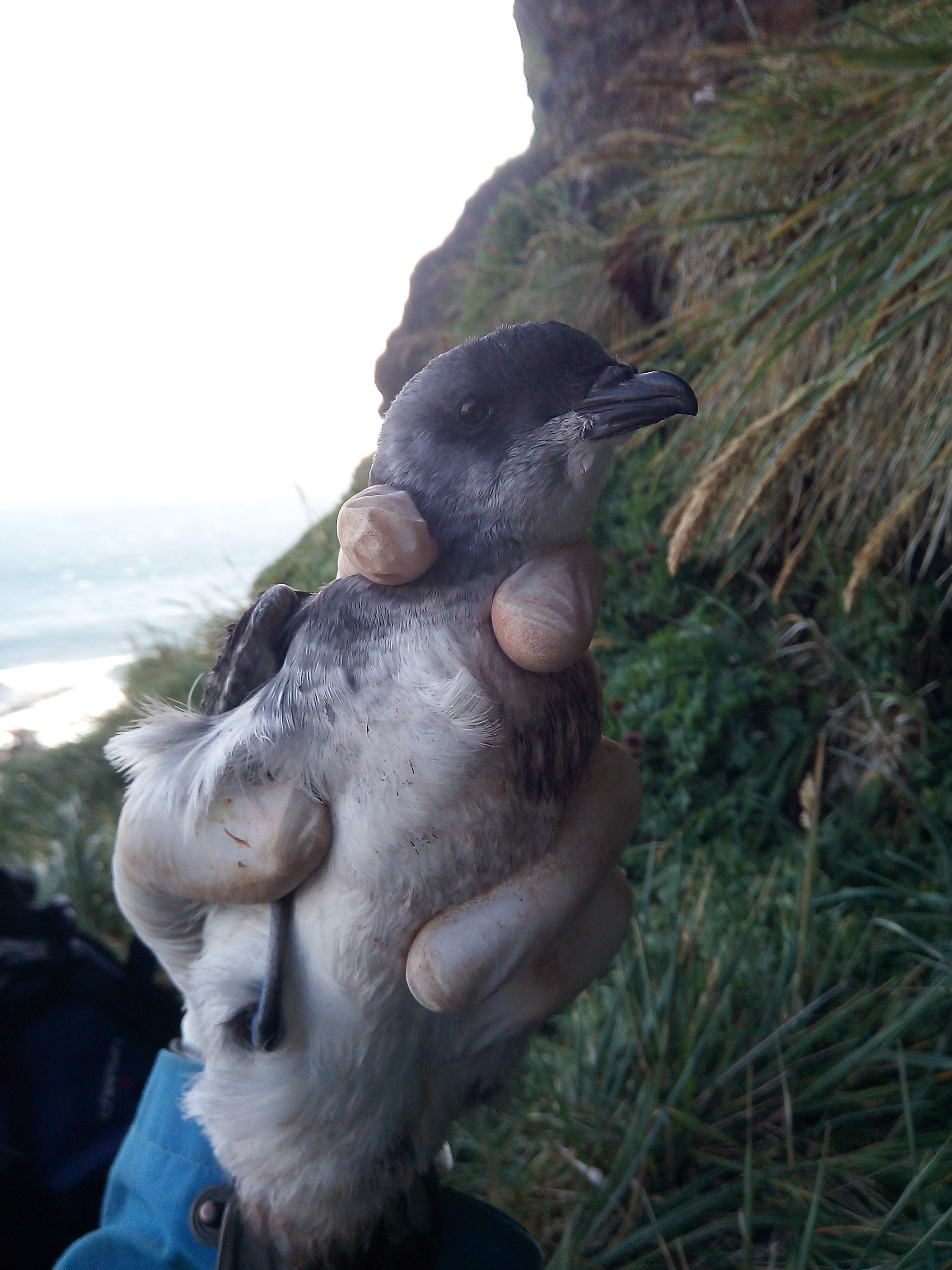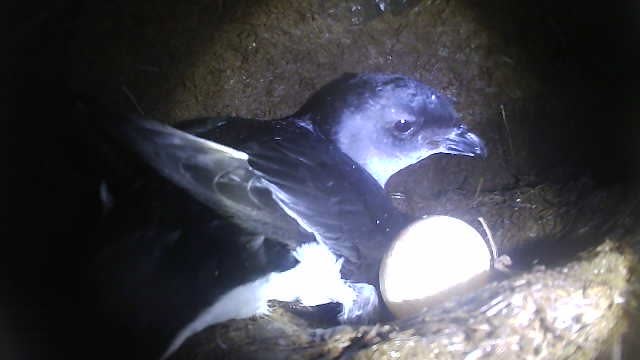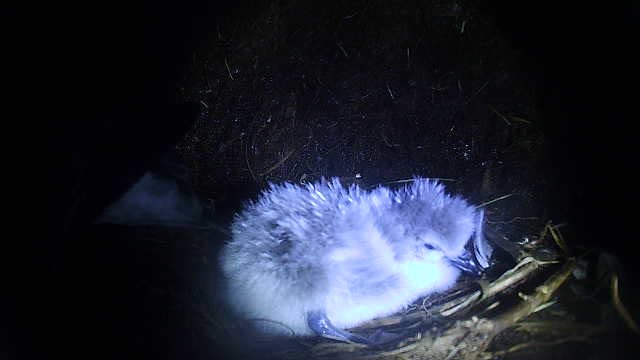
Common Diving Petrel in the hand on Marion Island, photograph by Stefan Schoombie
Maëlle Connan (Marine Apex Predator Research Unit, Institute for Coastal and Marine Research, Nelson Mandela University, Gqeberha, South Africa) and colleagues have published in Ostrich Journal of African Ornithology on the recent recolonisation of Marion Island by Common Diving Petrels Pelecanoides urinatrix, over two decades after the eradication of feral cats Felis catus in 1991. The cats were introduced in 1948 and are thought to have caused the diving petrels’ extirpation soon afterwards.
Lead author Maëlle Connan writes to ACAP Latest News: “further work is needed to understand the reasons for the low hatching success observed and whether predation by House Mice Mus musculus mice may be a contributing factor”.


At risk to mice? Burrowscope photographs of a Common Diving Petrel adult alongside its egg (left) and a chick (right); by Stefan Schoombie
The paper’s abstract follows in English and French:
Nocturnal burrow-nesting seabirds are notoriously difficult to study and can go unnoticed for years in remote areas. One of these species is the Common Diving Petrel Pelecanoides urinatrix, which has a circumpolar breeding distribution in the Southern Ocean, including at the sub-Antarctic Prince Edward Islands. At Marion Island, the larger of the two islands, the species was extirpated by cats that were introduced in 1948. The cats were eradicated by 1991, and Common Diving Petrels were discovered in burrows in coastal Poa cookii (Cook’s tussock grass) on a steep south-facing slope in Goodhope Bay during April 2015. Subsequent surveys in October 2015 and February 2016 confirmed breeding over a 1-ha area. In 2019/2020, breeding phenology and success was studied in 36 nests at the same site. Birds called from their burrows from mid-September, laying started in early October, and the first chick was observed on 20 December. Hatching peaked in early January and chicks fledged from the end of February to mid-March. This breeding phenology is similar to that at the neighbouring Crozet Archipelago. Overall nest survival was 46.4 ± 9.2% (mean ± SE; 95% CI: 29.5–64.1%), with most failures happening around hatching time. Further monitoring is needed to assess whether introduced House Mice Mus musculus contributed to the low hatching success. Common Diving Petrels were discovered breeding in other coastal areas, mostly in the south and east of the island. It is unlikely that breeding by this species was overlooked for three decades, suggesting that the elimination of cats allowed Common Diving Petrels to recolonise the island.”
Recolonisation naturelle de l’île subantarctique Marion par le Puffinure plongeur Pelecanoides urinatrix
Il est notoirement reconnu que les oiseaux de mer qui nichent la nuit dans des terriers sont difficiles à étudier et peuvent passer inaperçus pendant des années dans les régions éloignées. L’une de ces espèces est le Puffinure plongeur Pelecanoides urinatrix, qui a une distribution de reproduction circumpolaire dans l’océan austral, comprenant les îles subantarctiques du Prince-Edouard. Sur l’île de Marion, la plus grande des deux îles, cette espèce a été extirpée par des chats introduits en 1948. Les chats ont été complètement éradiqués en 1991 et au cours du mois d’avril 2015, des Puffinures plongeurs ont été découverts dans des terriers situés dans d’épaisses touffes d’herbes Poa cookii (tussock) de la zone côtière, sur une pente raide orientée au sud de la baie de Goodhope. Des recherches complémentaires menées en octobre 2015 et février 20216 ont confirmé la zone de reproduction sur une superficie d’environ 1 ha. La phénologie et le succès de reproduction de 36 nids localisés sur le même site ont été étudiés sur la période 2019-2020. Les oiseaux ont crié depuis leur terrier à partir de mi-septembre, la ponte a commencé début octobre et le premier poussin a été observé le 20 décembre. Le pic d’éclosion a eu lieu début janvier et les poussins se sont envolés de fin février à mi-mars. Cette phénologie de reproduction est similaire à celle observée sur l’archipel voisin de Crozet. Le taux de survie globale des nichées était de 46.4 ± 9.2% (σ; IC95%: 29.5–64.1%), la plupart des échecs se produisant autour de la période d’éclosion. Une surveillance complémentaire est nécessaire pour estimer si les souris domestiques Mus musculus introduites jouent un rôle dans le faible succès d’éclosion. Des zones de reproduction du Puffinure plongeur ont été découvertes dans d’autres zones côtières, principalement au sud et à l’est de l’île. Il est peu probable que la reproduction de cette espèce ait été négligée pendant trois décennies, ce qui laisse supposer que l’élimination des chats a permis au Puffinure plongeur de recoloniser l’île.
With thanks to Maëlle Connan and Stefan Schoombie..
Reference:
Connan, M., Schoombie, S., Schoombie, J., Dilley, B. & Ryan, P.G. 2022. Natural recolonisation of sub-Antarctic Marion Island by Common Diving Petrels Pelecanoides urinatrix. Ostrich doi.org/10.2989/00306525.2022.2150706.
John Cooper, ACAP News Correspondent, 20 December 2022

 Español
Español  English
English  Français
Français